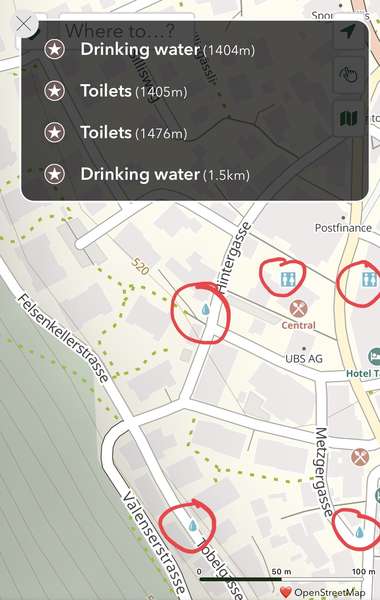
Become a supporter
Hi,
Despite nearby water fountains and toilets appearing on the map, the app only lists ones that are farther away.
Screencap from Bad Ragaz, Switzerland. Maybe I’m missing something? Thanks.

I just finished 3 weeks cycling in the UK, where I think I was using the cycle.travel website and app about 12 hours per day :) The route browser map — and maps of my own route folders — were so useful for planning, and of course the routing engine itself is brilliant.
A few comments on using the iPhone app for several trips over the past year.
I really love planning routes and riding them with the site and app. Thanks for making it possible!
Hi, due to the rounded window corners in MacOS and rounded screen corners on newer iPads, the ✍️ is difficult or impossible to actually click/tap. Sometimes I can use the accessibility screen zoom features to access it, but often this doesn't work.
The issue presents in Safari on Mac and iPad, and in Brave browser on MacOS.
I don't really have any good suggestions -- maybe add an "edit in OSM" option behind the ... menu on via points.
Screen captures on iPadOS actually don't show the corner radius -- I attached a photo.

www.lakesdalesloop.co.uk/introduction/
The Lakes & Dales Loop is a spectacular, 196-mile on-road cycle route through the best of Cumbria’s countryside.
Meander along gently undulating country lanes to explore the majestic beauty of the Lake District, West Cumbria, Morecambe Bay, the Yorkshire Dales and the Eden Valley. Riding the Lakes & Dales Loop reveals the rugged splendour of lesser-known corners of Cumbria away from the crowds.
On your journey through this ever-changing landscape, you will circumnavigate the Lake District, England’s largest National Park with wonderful views of iconic mountain tops. Starting from Penrith, heading west the route passes under the imposing shadow of Blencathra, the ‘back o Skiddaw’ and surrounding fells, past fortified manor houses and little hamlets towards the bustling town of Cockermouth, birthplace of William Wordsworth.
The route continues past the picturesque shores of Loweswater and over the expansive heather-clad Ennerdale Fells with views across the Irish Sea.
Turning east, the network of minor roads in South Lakeland, mostly well-kept secrets from the majority of motorists will ensure a peaceful day’s journey in the saddle, discovering some of the hidden gems of this part of the world. Give yourself time to stop off for refreshments at slate-floored Lakeland pubs, or cosy tea rooms with regional specialities such as Cumberland sausage, or a slice of Grasmere gingerbread.
The route leads you close to the famous sands of Morecambe Bay at Grange-over-Sands and across the ‘Witherslack Mosses’ (raised bogs) that border the Kent Estuary towards Sizergh Castle. The next highlight is the fascinating limestone landscapes of Farleton Knott and Hutton Roof Crags, as well as valley bottoms full of sheep, meadows, dry stone walls and scattered with field barns.
Heading north up the Lune Valley and passing through the delightful towns of Kirkby Lonsdale and Sedbergh (well worth an explore) you enter the tranquil Eden Valley, first across the open limestone landscape of Great Asby Scar and then into the market town of Appleby on the River Eden, show-casing fine historic buildings. Continue through scenic, rural landscapes to swing back round to the town of Penrith – an elegant and vibrant regional centre.
The exciting, new Lakes & Dales Loop gives you the chance to get up close to many of Cumbria’s spectacular landscapes, beautiful villages, distinctive heritage and rich culture. Don’t miss the opportunity to be among the first to uncover this new cycling ‘pot of gold’.
Some simple facts and figures
Although the route takes in the Lake District and Yorkshire Dales National Parks, there is very little climbing with a total ascent of just 5,172 metres (16,968 ft). Not bad when you consider you are surrounded by spectacular views of mountains.
This circular route offers an accessible, long distance challenge ride or tour for all cycling interests and abilities. Rides could be a single day event for cyclists who are looking for the next challenge or a less strenuous ride over six days.
Log in with your cycle.travel account:
| Password |
Or simply use your account on: